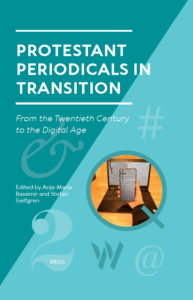Print Matters: Protestant Periodicals in Transition From the Twentieth Century to the Digital Age
In our Print Matters series we present recent academic books in the field of Religious Studies. What transitions do editors Anja-Maria Bassimir and Stefan Gelfren see when it comes to protestant periodicals? What is the role of periodicals now and in the future and how can editors and others be prepared?
Interview with the editors, Anja-Maria Bassimir and Stefan Gelfgren.
Question: What kind of transitions do you see in protestant periodicals?
Answer: One transition we highlight in this volume is the transition from print to digital, fueled especially by new technological developments and market factors. This transition impacts both the “material” framework (analogous to digital technology) and content (the possibility to publish and integrate a variety of media formats into one “publication” and to adapt content to a quicker pace of publications and to screen format – to be read on the run, so to speak). However, the changes wrought by this transition are not so great that we no longer recognize the new product – even though it is distributed through a variety of platforms. Indeed, we still speak of magazines, newspapers, or journals, even if some are now digital-only. Accordingly, this volume also emphasizes the continuities between older, more traditional forms and newer, digital forms of periodicals and the role they play in religious communities.
Question: What role do the periodicals play when it comes to engaging with and influencing the surrounding society?
Answer: One question we asked was whether there is something distinct about religious periodicals compared to periodicals in general. Our answer in this volume is summed up in the role periodicals play for the religious community on one hand, and for reaching out to society, on the other hand. The contributions in this volume investigate the periodical as a means of (re)invoking the community of faith and negotiating who belongs. Some case studies also illustrate how the periodical functions as a means of intervening in a larger discourse, either in straight-forward missionary fashion or through more subtle forms of outreach or politics. These chapters stress that religious communities are always situated within societal contexts and often are not only shaped by them but often also engage with and try to shape them. As we say in the book, “Periodicals here function to winsomely or persuasively portray a religious worldview and campaign for its application to societal issues.”
Question: How do you see the future of these periodicals considering digital developments? And how can editors and other developers prepare for it?
Answer: One challenge all religious communities face is to make their traditional, time-honored faith relevant to new generations. In some ways, periodicals are a type of media well suited to this task. One defining characteristic of a periodical is its seriality: new installments of the “same” periodical get published in a more or less regular rhythm. Those involved in making a periodical have developed certain designs and recurring features that make the product recognizable as the “same” even though every issue is new. Because of this feature, back-issues create an archive not only of the periodical but can also serve as a religious community’s memory. Yet seriality also allows periodicals to present “old truths” in “new skins,” so to speak, and thus present the opportunity to make religion relevant to its constituency with every new issue. Digital media are just the latest technological development in this regard. Being online allows religious periodicals to interact with constituents in the environment where everyone in general, but the younger generations in particular, increasingly spends their time. The integration of digital publications into everyday life, through digital publication on a variety of platforms, is an opportunity; at the same time, the danger is that it disappears in an continuous stream of digital information. Here the book can give perspectives and help to understand the history and future of periodical publication.
About the Editors

Anja-Maria Bassimir is Assistant Professor and postdoctoral researcher at the Obama Institute for Transnational American Studies at the Johannes Gutenberg University Mainz, Germany. She studied history and religious studies in the U.S. and Germany. She has been working in Mainz since 2013, first in the DFG Research Group UnDoing Differences on a project on religious periodical studies and since 2021 in the SFB Human Categorization on a project on transnational U.S. American food policy. She is coeditor of Religious Periodicals and Publishing in Transnational Contexts: The Press and the Pulpit; her book Evangelical News: Politics, Gender, and Bioethics in Conservative Christian Magazines of the 1970s and 1980s was published with Alabama University Press in 2022.

Stefan Gelfgren is Associate Professor of the Sociology of Religion, at the Department of Historical, Philosophical and Religious Studies at Umeå University, Sweden. He has a background in the History of Ideas (PhD from Umeå University), and in the History of Christianity (MPhil from University of Birmingham). His current work focuses on present-day churches’ and denominations’ use of digital media. He has also done work in the field of nineteenth century Evangelical revivalism. His main research interest is the relation between societal and technological changes in context with changes in religious faith and practices throughout history, as well as an interest in surveillance studies.
About the Book
Go here to find out more.
About Print Matters
RESILIENCE is unique, also in the sense that it focuses on both digital and physical data such as manuscripts, letters, books, etc. Physical sources remain essential for Religious Studies and so are printed books for the communication of research on religion. In Print Matters we present recent academic books in the field of Religious Studies, books on relevant topics with an innovative approach.
